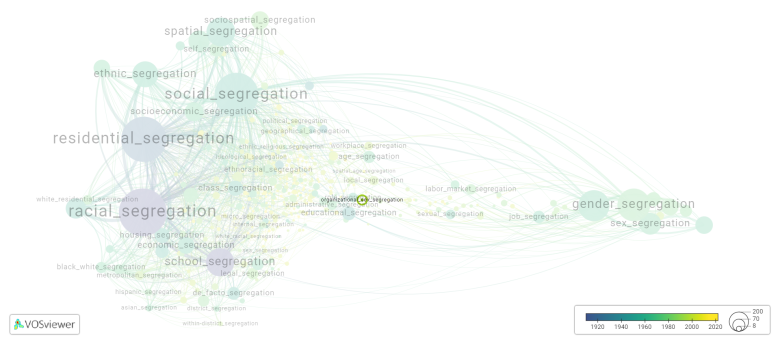Organizational sex segregation: Difference between revisions
(Creating page) |
(Creating page) |
||
| (9 intermediate revisions by the same user not shown) | |||
| Line 1: | Line 1: | ||
===== Date and country of first publication<ref>Date and country of first publication as informed by the Scopus database (December 2023).</ref>===== | |||
2005<br> | 2005<br> | ||
Sweden | |||
===== Definition ===== | |||
Organizational sex segregation refers to the phenomenon where individuals of different sexes are disproportionately represented in different roles or positions within an organization. This can include gender-based differences in job roles, occupational fields, promotional opportunities, and overall representation within certain industries or organizations. | Organizational sex segregation refers to the phenomenon where individuals of different sexes are disproportionately represented in different roles or positions within an organization. This can include gender-based differences in job roles, occupational fields, promotional opportunities, and overall representation within certain industries or organizations. | ||
| Line 10: | Line 12: | ||
Many organizations have recognized the importance of addressing organizational sex segregation and promoting gender equality. Efforts have been made to implement diversity and inclusion initiatives, promote equal opportunities, and challenge gender stereotypes and biases. However, there is still work to be done to achieve true gender equality and reduce organizational sex segregation in many industries and organizations. | Many organizations have recognized the importance of addressing organizational sex segregation and promoting gender equality. Efforts have been made to implement diversity and inclusion initiatives, promote equal opportunities, and challenge gender stereotypes and biases. However, there is still work to be done to achieve true gender equality and reduce organizational sex segregation in many industries and organizations. | ||
==See also== | ==See also== | ||
==Related segregation forms== | |||
Organizational sex segregation is frequently discussed in the literature with the following segregation forms: | |||
[[sex segregation]] | |||
[[File:organizational_sex_segregation.png|780x780px]] | |||
This visualization is based on the study [[Segregation_Wiki:About| The Multidisciplinary Landscape of Segregation Research]]. | |||
For the complete network of interrelated segregation forms, please refer to: | |||
* [https://tinyurl.com/2235lkhw First year of publication] | |||
* [https://tinyurl.com/2d8wg5n3 Louvain clusters] | |||
* [https://tinyurl.com/223udk5r Betweenness centrality] | |||
* [https://tinyurl.com/244d8unz Disciplines in which segregation forms first emerged (Scopus database).] | |||
==References== | ==References== | ||
== | ==Notes== | ||
<references /> | |||
{{NoteAI}} | |||
==Organizational sex segregation appears in the following literature== | |||
Bygren M., Kumlin J. (2005). Mechanisms of organizational sex segregation: Organizational characteristics and the sex of newly recruited employees. ''Work and Occupations'', ''32''(1), 39-65. https://doi.org/10.1177/0730888404265771 | |||
Sappleton N., Takruri-Rizk H. (2008). The gender subtext of science, engineering, and technology (set) organizations: A review and critique. ''Women's Studies'', ''37''(3), 284-316. https://doi.org/10.1080/00497870801917242 | |||
Latest revision as of 07:17, 16 October 2024
Date and country of first publication[1][edit | edit source]
2005
Sweden
Definition[edit | edit source]
Organizational sex segregation refers to the phenomenon where individuals of different sexes are disproportionately represented in different roles or positions within an organization. This can include gender-based differences in job roles, occupational fields, promotional opportunities, and overall representation within certain industries or organizations.
Historically, women have faced significant barriers and discrimination in accessing certain roles or achieving top positions within organizations, resulting in organizational sex segregation. This can be due to various factors, including bias and stereotypes, lack of equal opportunities, and societal expectations of gender roles.
Organizational sex segregation can have several negative implications. It perpetuates gender inequalities in the workplace, limits career advancement opportunities for certain individuals, and contributes to the gender pay gap. It can also lead to a lack of diversity and the creation of workplace cultures that are not inclusive and representative of the wider society.
Many organizations have recognized the importance of addressing organizational sex segregation and promoting gender equality. Efforts have been made to implement diversity and inclusion initiatives, promote equal opportunities, and challenge gender stereotypes and biases. However, there is still work to be done to achieve true gender equality and reduce organizational sex segregation in many industries and organizations.
See also[edit | edit source]
Related segregation forms[edit | edit source]
Organizational sex segregation is frequently discussed in the literature with the following segregation forms:
This visualization is based on the study The Multidisciplinary Landscape of Segregation Research.
For the complete network of interrelated segregation forms, please refer to:
References[edit | edit source]
Notes[edit | edit source]
- ↑ Date and country of first publication as informed by the Scopus database (December 2023).
At its current state, this definition has been generated by a Large Language Model (LLM) so far without review by an independent researcher or a member of the curating team of segregation experts that keep the Segregation Wiki online. While we strive for accuracy, we cannot guarantee its reliability, completeness and timeliness. Please use this content with caution and verify information as needed. Also, feel free to improve on the definition as you see fit, including the use of references and other informational resources. We value your input in enhancing the quality and accuracy of the definitions of segregation forms collectively offered in the Segregation Wiki ©.
Organizational sex segregation appears in the following literature[edit | edit source]
Bygren M., Kumlin J. (2005). Mechanisms of organizational sex segregation: Organizational characteristics and the sex of newly recruited employees. Work and Occupations, 32(1), 39-65. https://doi.org/10.1177/0730888404265771
Sappleton N., Takruri-Rizk H. (2008). The gender subtext of science, engineering, and technology (set) organizations: A review and critique. Women's Studies, 37(3), 284-316. https://doi.org/10.1080/00497870801917242

